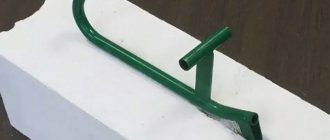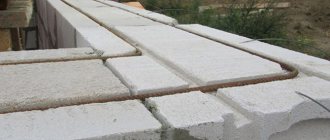Wall chaser - what it is and how it works
Structurally, a wall chaser is similar to a circular saw. It has a protective casing, a motor block and two cutting discs located at a distance from each other. This gap can be adjusted, thereby changing the width of the future furrow. The depth is also not fixed and can change due to an increase in the angle of immersion of the disks into the material.
Industrial wall chasers are sometimes completely different from angle grinders
Wall chasers have high power, a convenient handle for creating pressure on the discs during operation, a system for quickly replacing discs and adjusting their width. Some models can be connected to a vacuum cleaner to remove dust and debris.
Wall chaser design and functions
Structurally, this universal tool is most similar to an angle grinder (angle grinder), which in everyday life is called an angle grinder. It is widely believed that this is an angle grinder with two discs. Frankly speaking, it is almost correct. The main difference is that the wall chaser is equipped with a powerful electric motor, usually with the ability to control speed and smooth start. Good models have overheating and overload protection functions. In case of significant loads, they will allow you to save the tool.
The wall chaser uses diamond discs, the distance between them is adjusted to obtain a groove of the required width (usually up to 60 mm). For safety reasons, they are covered with a special casing. In addition, the casing has an outlet for connecting a vacuum cleaner, this allows minimizing the emission of dust during gating. To obtain the required depth, it is equipped with a special adjustable stop (usually up to 80 mm).
With the help of an attachment for an angle grinder, you can completely replace the wall chaser.
Models of wall chasers and how they work
Let's look at several concrete wall chasers to understand the design, operating principle and capabilities.
Interskol PD-125/1400E
Wall chaser from a domestic manufacturer. Two 125 mm discs are capable of making a furrow up to 30 mm deep and up to 30 mm wide. The power of the unit is 1400 W. And the maximum number of revolutions is 9500 per minute. The cost of this tool is about 6,000 rubles.
This wall chaser is very similar to an angle grinder, perhaps it is based on it
Bosch GNF 35 CA
A more productive version of a manual wall chaser for aerated concrete, concrete and brick. 2 cutting discs 150 mm each. The maximum groove width is 39 mm, and the maximum depth is 35 mm. The power of the device is 1400 W. The design involves connecting a vacuum cleaner and removing dust and debris. The cost of such a tool is quite high - 40,000 rubles.
A convenient and practical tool, although a little expensive
Makita SG150
Powerful and productive wall chaser. The cutting depth can reach 45 mm and the width 35 mm. The power is 1800 W, but the number of revolutions is slightly lower than usual - 7800 rpm. You can also connect a vacuum cleaner to it. The device costs about 42,000 rubles.
Functional and powerful option
A little about gating
A groove (the term “furrow” is less commonly mentioned) consists of two parallel grooves, the width and height of the walls of which determine the possibility of installing communications in it. To make grooves, the following groove dimensions are required:
- Width from 3 to 50 mm (the first option provides for laying only power and low-current cables in the groove, the second - for installation of heating system pipes);
- The depth of the groove is no less than its width, but it is better with a small margin of 5...10 mm;
- The bottom of the groove is smooth, without protrusions.
Sometimes you have to cut inclined grooves. For oblique grooves, all specified dimensions are usually increased by 10...12%. The groove should be as even as possible, since any slope of the groove will automatically increase the length of the cable or pipe. The distance from the groove axis to adjacent ceiling structures, openings, etc. must be at least 150 mm, and to the gas pipeline elements - at least 400 mm.
The material of the walls also matters. Since the groove is obtained by removing material from under the tool disk, all dust and stone fragments fall into the worker. Even when performing such work in walls made of foam or aerated concrete, the need for dust collection is very important, since fine dust will remain in the air for a long time.
In a professional wall chaser, all these problems are solved by connecting a vacuum cleaner with a cyclone filter to the tool. Ordinary mesh ones will become clogged with gating products within a few seconds of continuous operation of the wall chaser.
The second significant difference between gating with a specialized tool is the presence of a movable frame with wheels, which, when controlled, can significantly reduce the load on the worker’s hands. A single-disc wall chaser attachment for an angle grinder does not fundamentally solve the problem, since the depth of the groove is not limited in any way, and manual removal of the jumper is very labor-intensive and does not ensure good quality of the bottom of the resulting groove. In addition, during the second pass it will not be easy to achieve parallelism of the walls of the groove.
How not to buy an extra tool - a slotting attachment for an angle grinder
The groove attachment for an angle grinder is a good alternative that will help you save on the purchase of an expensive separate tool. In the simplest case, this is a slightly modified casing for an angle grinder and an additional disk on the tool shaft. In this case, the angle grinder must meet the power requirements - have at least 1500 W. You won’t be able to buy a wall chaser attachment for an angle grinder in a store, since it is a multi-part unit. But you can find a casing with an increased distance for an additional disk, with a hood and an automatic mechanism for tilting the casing for safety.
Protective guard with adjustable cutting depth
How to make a wall chaser from a grinder
You can make a manual wall chaser with your own hands. For aerated concrete, concrete and brick. This will be cheaper, but will require certain skills and the availability of other auxiliary tools, for example, a welding machine, drill, lathe. As a rule, there are no drawings for a wall chaser made from an angle grinder yourself. Everything is done based on their own needs, the availability of a certain type of angle grinder and capabilities.
Making a protective casing
Probably the most crucial moment in the entire process of manufacturing the wall chaser attachment for the angle grinder. To do this you will need welding skills and a welding machine. It is better to choose metal about 1-2 mm. This will provide better protection against fragments of concrete and the disk in the event of its flying apart. The area where the disks are placed should have a width with a margin of two disks, and in such a way that the total width can be adjusted up to 50 mm. The diameter of conventional concrete sawing discs is usually 125 mm. This is enough to make a furrow about 30 mm deep, which is quite enough for most communications. Therefore, the size of the casing should be slightly larger than the diameter of the discs used.
You can buy a casing for a wall chaser ready-made, but its width does not always correspond to the desired one
In the design of the casing, it is necessary to take into account the outlet to which the vacuum cleaner for the wall chaser will be connected. With your own hands you can select the diameter of the hole to suit the required one. In principle, it can be done without it, however, this will significantly worsen the efficiency of the wall chaser and the service life of the discs. And working in dust is not so comfortable.
The reference plane will help to avoid uneven cutting depth
The supporting plane or sole is also made of metal. A slot is made in it with a margin for the maximum width of two disks. The ideal option would be to make a sole with a fixed depth. This will allow the grooves to be cut to the desired depth. It is also a good idea to take care to tilt the sole beyond the line of action of the discs to avoid injury. Installing a spring on the fastening mechanism can help with this.
There are some pretty brutal solutions
The fastening system can be repeated from any original casing, which, in essence, is a clamp with a bolt and a fixed nut. As mentioned earlier, you won’t be able to buy a groove attachment for an angle grinder as such. There are only modified casings that can speed up the conversion process a little.
Shaft or nut
In order to attach the second disk to the grinder, the length of the standard shaft may not be enough, especially for cutting wide grooves. Here you can go two ways: buy or make an extended shaft, or buy or make a special nut with fastening for the second disk.
Standard shaft for angle grinder
Finding a ready-made shaft will be quite difficult, because manufacturers produce them extremely rarely. You can turn it on a lathe yourself or order this work at any turning shop.
In general, you can use various tricks - place a puck, for example
But most often a special nut is used. Finding it or making it is easier. Structurally, it is a clamping nut, on the other side of which there is another one with a small shaft. A second disk is placed on it and secured with another nut. For narrow grooves up to about 0.8-1 cm, you can get by with two standard nuts. The first disk is placed as usual, and the second one is placed on top, after which it is secured with a second nut.
If you need a narrow groove, you can do without special nuts and shafts
The approximate result of a finished wall chaser made from a grinder with your own hands is in the video:
How to make a nozzle with your own hands
The following are videos demonstrating the process of making a casing for an angle grinder with your own hands. Craftsmen use various materials and technologies for production.
Homemade for gating, for a vacuum cleaner
Dust extraction covers are the most popular type.
Homemade protective casing for a diamond bowl from a plastic stand, corner and clamp
The base for the cover is a plastic stand for a flower pot.
A hole is made in the center: several cuts are made, the workpiece is heated and the edges are moved back.
A hole is formed at the edge for the PVC corner, which is then attached by soldering to the stand.
It is recommended to cover the rim with thick fabric or foam rubber to trap debris.
Casing made of a plastic bowl, pipes with a diameter of 40 mm. and clamp
To make it you will need a plastic cup and a pipe with a diameter of 40 mm. and a clamp.
A hole is drilled in the center of the bowl using a drill, “petals” are cut, and the edges are moved back by placing a pipe in the hole.
The workpiece is tried on a drill, the “petals” are cut off a little.
Using a clamp, the workpiece is attached to the angle grinder and made smaller in height; unnecessary parts are removed with scissors.
To make a dust extractor, another hole is made. The pipe is attached to the workpiece using wire stitching, and the joint is coated with silicone.
On the inside, the edges of the cover are covered with double-sided tape and door tape, which will keep dust out.
https://www.youtube.com/watch?v=wop1TDftMj0
Upgrading the metal casing with a dust extractor and a curtain to adjust the cutting depth
Two plates of a similar shape are welded to the metal casing, thereby providing greater protection to the nozzle.
A hole is formed on the cover, a tube with a diameter of 25 mm is welded, i.e. dust removal is done.
There will also be a movable plate on the bottom side of the nozzle, which is secured using a curtain welded to one of the sides.
On the other side, a plate with holes for a bolt is attached. It is used to adjust the cutting depth.
In the plate located on the bottom side, a grinder is used to form a slot for the discs.
The product is painted.
Exhaust hood for angle grinder discs with a diameter of 125 mm. off-center
For production you will need an empty paint container, a crimp clamp from 40 to 50 mm, and a corner from a plumbing pipe with a diameter of 30 mm. and a small piece of pipe.
In the bottom of the plastic container, in the center and not far from the edge, two holes of different diameters are formed with a knife.
A grinder is placed in the first and fixed with a clamp, in the second there is a pipe, the edge of which is cut into several “petals” bent at an angle of 90 degrees for fastening.
The excess part of the container is removed.
For grinding
When sanding different types of surfaces, it is also recommended to use a housing with a dust extraction.
Metal Dust Cover for Grinding Concrete Walls and Floors with Diamond Blade
A hole is formed on a drilling machine in the center of the metal cup, and a clamp is welded on top.
The workpiece is fixed and the excess part is cut off with a grinder, the edges are cleaned.
Near the edge of the workpiece, another hole is formed for the dust extraction, into which the tube is placed, and the connection is covered with silicone.
Protective
A protective casing is a mandatory element when processing metal parts, as a result of which there is a risk of damage to the worker from flying sparks and particles.











